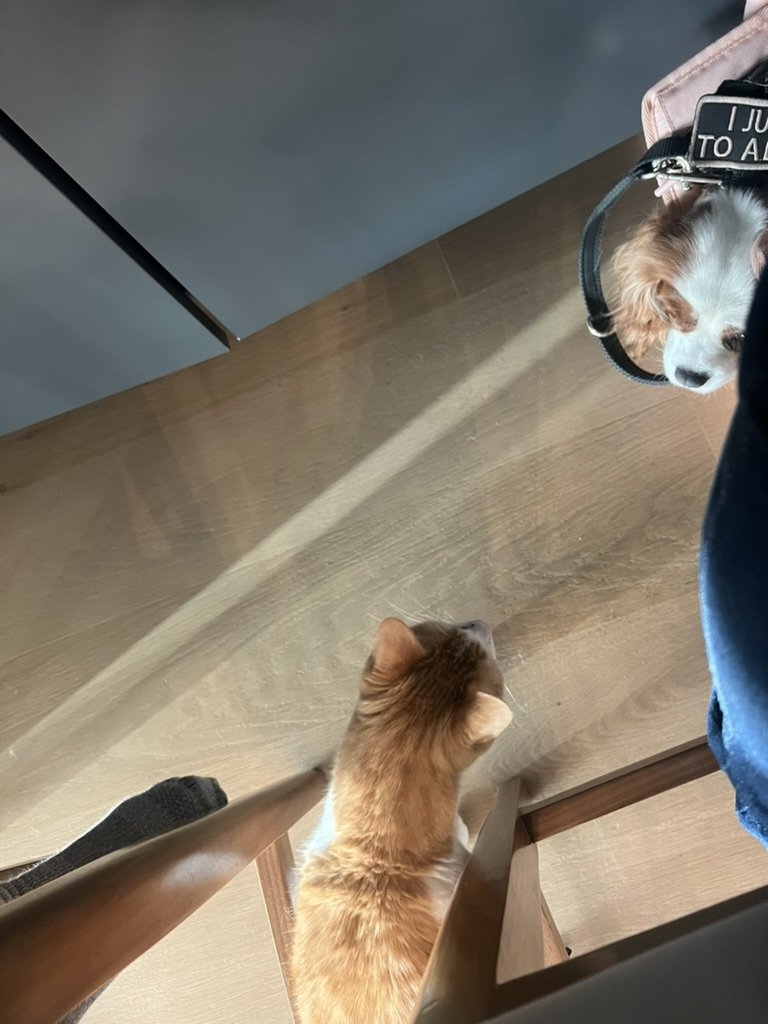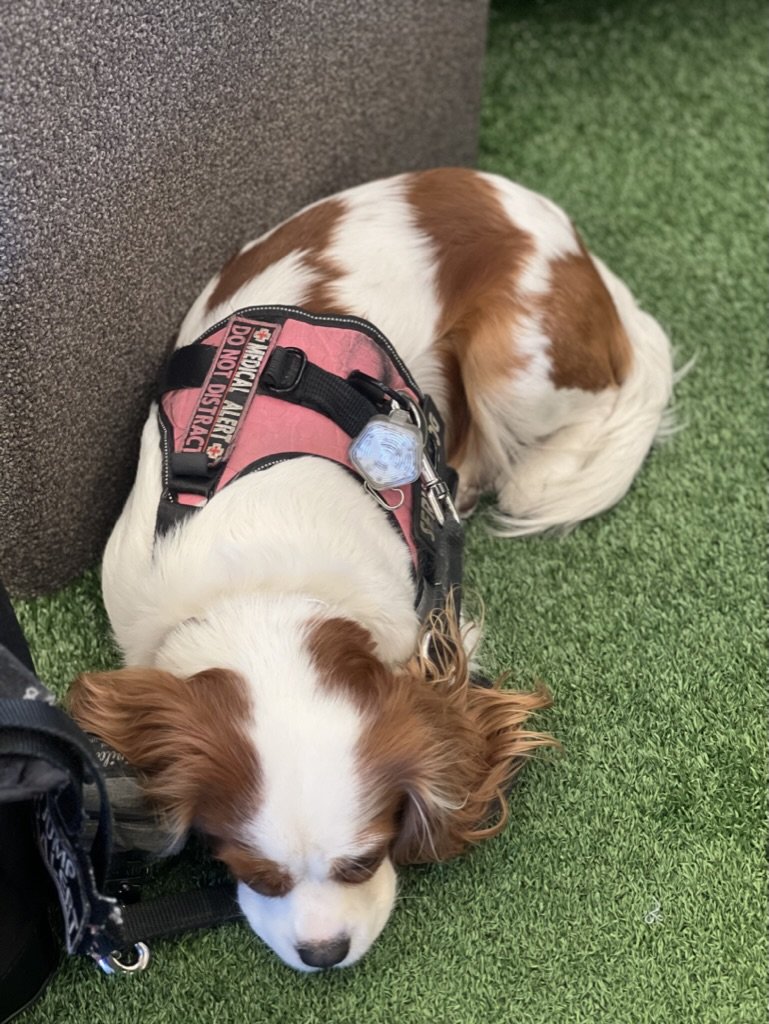Teaching with a Service Dog Part 2: Navigating Employment and Clientele
Welcome back, everyone! In Part 2 of our journey through teaching with a service dog, we're diving deep into the challenges of finding a job and clients when you've got a furry friend by your side.
In Part 1, we met my amazing service dog, Estrellita, and discussed the joys of teaching with her. But now, let's tackle the tough stuff – discrimination in the workplace and client concerns.
Imagine acing an interview, only to face resistance when you mention your service dog. It's a reality many of us face. I've had my fair share of experiences, like one where I was told, "We don't accept pets," despite explaining ADA laws.
But fear not! We're shedding light on these issues and advocating for change. By sharing our stories and educating others, we're creating a more inclusive environment for service dog educators.
So, join us on this journey to promote understanding, advocate for inclusivity, and pave the way for a brighter future. Read the full blog to learn more about navigating challenges and championing diversity with a service dog by your side! 🐶✨
As a service dog that goes to school, is the difficulty of children wanting to pet the “doggie” Every time that happens is a moment of opportunity to teach them about not only about service dogs about how to approach a dog correctly. Here as “Estrellita’s treat” I allowed her to receive pets from a student.
Hey there, folks! Welcome back to Part 2 of our journey through the world of teaching with a service dog. Buckle up because today, we're diving deep into some real talk about the challenges that come with finding a teaching job and getting clients when you've got a furry companion by your side.
But before we dive in, let's do a quick recap of Part 1. We talked about the joys and triumphs of teaching with a service dog and introduced my amazing teacher assistant, Estrellita – the one and only. She's not just any dog; she's a certified Service Dog. And not just any service dog, mind you – she's a Medical Alert Dog and a PSD, and let me tell you, she's the best Cavalier King Charles Spaniel you'll ever meet. Yep, she's as wonderful as she sounds.
Now, onto Part 2 – the challenges. You see, despite the invaluable aid that Estrellita provides, navigating the world of employment and clientele can be a bit of a maze when you have a service animal. It's like trying to find your way through a forest without a map tripping over unseen obstacles – It’s tricky, to say the least. So, I really do help that these blogs will help my fellow educators with service dogs with the knowledge and confidence that they need when it comes to teaching.
Even off the clock she will come to me when she senses something is off. She will climb on me to lay on my desk sometimes as I teach online. I could at least make sure she is comfortable.
Alright, let's tackle a tough topic – discrimination in the workplace, specifically for individuals with service dogs looking to land teaching jobs. It's a sad reality, but one that we can't ignore.
First off, let's talk about how common this discrimination really is. Unfortunately, it's all too prevalent. Imagine this: you've aced the interview, wowed them with your skills, and then, just when you think you've sealed the deal, you drop the bombshell – you have a service dog. Suddenly, the tone changes, and you're met with resistance.
But don't just take my word for it – let me share one of my experiences. I was interviewing for a professor position at a university in Southern California. The interview was going swimmingly; the interviewer was impressed with my background and loved my mock lesson. Then, I drop the bomb – I mention that I have a service dog.
And just like that, the tone shifted. The interviewer hesitated and said, "We don't accept pets." Diplomatically, I explained that my service dog isn't a pet – she's a working dog, trained to assist me with my disabilities. But despite my efforts to educate him about ADA laws and my rights, he remained adamant – "We don't allow pets."
Instances like these highlight the misinformation and confusion surrounding service animals. Despite federal laws protecting the rights of individuals with disabilities, discrimination still rears its ugly head, fueled by misconceptions and different forms of ignorance. I even called the human resources of that University and shared what had happened. Providing constructive feedback and educating others about people with service dogs is crucial. The lady that I spoke to was very apologetic and felt bad. When I made that phone call it wasn’t because I was angry, I got into my protective mode for others and to help share the knowledge.
Knowledge is power. By shedding light on these discriminatory practices and advocating for our rights, we can create a more inclusive and accepting environment for individuals with service animals in the workplace. We need to keep fighting the and standing up for what's right – one paw print at a time. 🐾
One of my students had a cat that just had to greet the guest. When I visit my students’ homes I always bring a carrier out of respect for my clients.
But what about the tutors out there? I have owned a tutoring business since 2009. I can not verbalize the emotions which included both excitement and fear when I was prescribed a service dog. Even though at the time I was teaching 100% online it still scared me about getting clients and everything. Then when I decided to do a combo of online and in-person. I was so worried. Would students be ok of me having a service dog? These were one of the questions that was running through my head.
Disclosing the presence of a service dog to potential clients. It's like walking a tightrope – on one hand, you want to be transparent and upfront about it, but on the other, you worry about how they'll react.
And boy, do they react. Common concerns and misconceptions abound when it comes to working with an educator who has a service animal. "Will the dog be a distraction?" "Can we trust the dog around our children?" Sound familiar? Yep, these are just a few of the questions that may pop up in potential clients' minds.
I try not to let it get me down. Instead, I take the time to address their concerns, dispel any misconceptions, and showcase the incredible bond I have with my service dog. And you know what? More often than not, they come around. Because at the end of the day, it's not about the dog – it's about the quality of education and support that I can provide. And fun fact did you know that dogs can help people learn better? I will be writing a separate blog on that in the near future. At the time, I’m writing this blog, I’m actually training Estrellita to be a therapy dog to help students at schools!
Alright, let's switch gears and talk about how schools handle the presence of service dogs, particularly when it comes to educators like us. It's a topic that's not always black and white, but with a little knowledge and understanding, we can navigate through it together.
First things first – how do schools verify the legitimacy of service dogs accompanying educators? Well, it varies from school to school, but typically, they may request documentation or certification from the handler to confirm that the service dog is indeed trained to assist with a disability. Yes, I know. That they are not allowed to ask that. Just like everywhere else, they are supposed to ask those 2 questions. Schools cannot not just say you may not enter or not teach there because they didn’t see the “evidence”. What they should do is bring it up to a school property and/or facility and/or school function then must be directed to the Superintendent, designee, or school site administer and deem that your service dog as “appropriate”. Sometimes, they might also observe the dog's behavior and interactions to ensure they're well-trained and well-behaved.
Now, let's talk legal rights and accommodations. As educators with service animals, we're protected under the ADA (Americans with Disabilities Act), which grants us the right to have our service dogs accompany us in educational settings. This means schools are legally obligated to provide reasonable accommodations to ensure our service dogs can do their job effectively.
But here's the biggest thing – communication is key. It's essential for educators to effectively communicate with schools about their service dogs and ensure their rights are respected. This might involve having open and honest discussions with school administrators for accommodations that meet both the needs of the educator and the students.
And let's not forget about strategies for navigating these conversations. Whether it's educating school staff about the role of service dogs, addressing any concerns or misconceptions they may have, or collaborating on a plan to ensure the smooth integration of the service dog into the educational environment, there are plenty of ways to approach the situation positively and proactively.
We've covered a lot of ground today, haven't we? From the challenges of finding employment to navigating client interactions, it's been quite the journey. But before we wrap things up, let's take a moment to reflect on what we've learned.
First off, let's talk challenges. Whether it's facing discrimination in the job market or overcoming misconceptions from potential clients, educators with service dogs have their fair share of hurdles to jump. But hey, we're a resilient bunch, aren't we? With a little perseverance and a whole lot of determination, we can overcome anything that comes our way.
But here's the thing – we can't do it alone. Addressing misinformation and advocating for inclusivity are crucial steps in creating a more accepting and understanding environment for educators with service dogs. Whether it's educating employers, clients, or colleagues about the role of service animals, every conversation counts.
So, let's keep the dialogue going. Let's keep educating, advocating, and sharing our stories. Together, we can promote understanding and acceptance of service animals in the teaching profession and beyond. Because at the end of the day, it's not just about us – it's about creating a world where everyone, furry companions included, can thrive. So here's to embracing inclusivity, championing diversity, and paving the way for a brighter future!
Teaching with a Service Dog PART 1
Welcome to the extraordinary world of teaching with a service dog, where every paw print represents a step towards breaking barriers and embracing inclusivity. As a learning specialist with a furry companion by my side, I've embarked on a journey filled with challenges, triumphs, and profound moments of connection.
Let me introduce you to my loyal partner in education – Estrellita, a certified PSD and Medical Alert Dog, and a beloved Cavalier King Charles Spaniel. Together, we navigate the complexities of the educational landscape, armed with determination, compassion, and a whole lot of wagging tails.
In this blog, we'll delve into the misconceptions surrounding service animals, the invaluable role they play in supporting individuals with disabilities, and the transformative power of education in embracing neurodiversity. Join us as we share personal experiences, confront stigma, and champion the importance of creating inclusive learning environments where every student can thrive.
After a long day of work.
Hey there, fellow educators, students, and all you wonderful folks interested in the fascinating world of service dogs and learning. Today, I'm thrilled to share a little slice of my life with you – teaching with my trusty sidekick, Estrellita.
Let's get personal for a moment. You see, I'm not just your average educator running a business. Nope, I'm a learning specialist with a furry colleague by my side – Estrellita, the one and only. She's not just any dog; she's a certified PSD (Psychiatric Service Dog) and Medical Alert Dog, and she happens to be a delightful Cavalier King Charles Spaniel. Yep, she's as wonderful as she sounds.
Now, let's address the elephant in the room – the misconceptions around service animals and emotional support animals (ESAs). It's like they're constantly getting mixed up in people's minds, but trust me, there's a big difference. ESAs provide comfort and emotional support, but service animals like Estrellita? They're trained for specific tasks that assist individuals with disabilities. Unfortunately, this confusion can lead to serious impacts, especially for those with disabilities. And trust me, as someone who's been there, I know just how crucial it is to set the record straight. Because misinformation leads to miseducation that leads to severe impacts to those that have disabilities.
But here's where it gets tricky – there's often a stigma attached to service animals. Some folks see them as nothing more than pets, failing to recognize the vital role they play in the lives of their owners. Especially when they see smaller dogs as service dogs. And let me tell you, navigating these misconceptions isn't easy and very much discouraging.
Whether it's in the professional realm or our personal lives, we're faced with challenges when it comes to educating others about the true purpose of service animals. But fear not, my friends, because we're about to dive headfirst into this topic and shed some much-needed light on the matter. So grab a cuppa, get comfy, and let's bust some myths together! 🐾
You see, running a tutor business can be a whirlwind of activity, teaching at schools or other learning enviornments is always a wonderful journey. But in addition to ADHD and the other gifts that the disorder brings, it can make life very challenging. But with Estrellita by my side, everything becomes a little easier. During tutoring sessions, Estrellita takes her role seriously. She's like my silent partner, always ready to lend a paw when needed. Whether it's sensing my brain fog, ADHD paralysis, nudging me to refocus or sensing an anxiety attack is coming up, she's a true pro.
She is being thankful she is not the one working out at the gym.
And let's clear the air about service dogs – they're not just for guiding the visually impaired or assisting those with mobility issues. Oh no, they can be trained for a variety of disabilities, from medical alerts to assisting with neurodevelopmental disorders and anxiety.
But her assistance goes beyond just the physical tasks. Estrellita has an innate ability to sense emotions and provide comfort in times of stress. For students grappling with neurodevelopmental disorders or various anxieties, her presence can be a game-changer. She creates a safe and supportive environment where learning can thrive, free from judgment or fear.
And let me tell you, the importance of service animals for individuals like myself with neurodevelopmental disorders cannot be overstated. Estrellita isn't just a pet; she's a lifeline, offering stability and support in a world that can often feel overwhelming.
When it comes to talking about neurodevelopmental disorders and the various types of anxiety, I’m not going to lie to you, I get nervous due to the stigma behind it. Let alone having a service dog to help you with that in your daily lives. As I mentioned before, confronting that stigma is not easy. But it is important to talk about it especially as an educator. It's a journey filled with highs and lows, but it's one that deserves our attention and understanding.
Now, speaking from personal experience, living with ADHD isn't always a walk in the park. It's like having a whirlwind in your brain, constantly swirling with thoughts and ideas. But with Estrellita by my side, I've learned to embrace the chaos and channel it into something positive.
But here's the thing – there's often a stigma attached to neurodevelopmental disorders and anxiety, especially in educational settings. Especially if either the professionals and/ or parents are not educated or updated in the topic. It's like wearing an invisible badge of shame, fearing judgment and misunderstanding from others. We try to do what we are asked, but there are times when we just can’t execute that task. It’s not an attitude problem. I like to describe it as our brain holding us hostage. But let me tell you, my friends, it's time to break free from these shackles and embrace our differences with open arms. It is our weaknesses that give us our strengths.
Because here's the truth – neurodiversity is a gift, not a curse. It's what makes each of us unique, bringing a richness and depth to our lives that can't be replicated.
I am sharing this with all of you to share with you why I decided to become a learning specialist. At first it all started with a desire to make a difference in the lives of students like you whether a teacher, or a high school student, or an adult learning Spanish for work. See, I've always believed that everyone deserves a chance to shine, regardless of their learning style or the challenges they may face. Everyone can improve on any skill that they desire with the right tools and resources. Traditional teaching methods don't always cut it. That's why I'm a firm believer in individualized teaching approaches, tailored to meet the needs of each student. Whether it's a one-on-one session or a group setting, flexibility is key.
Let me tell you about Sarah, a bright and bubbly student I had the pleasure of working with. Despite her intelligence and eagerness to learn, Sarah often found herself struggling to answer or say what she knew during class activities and tests. As we got deeper into the issue, it became clear that Sarah's struggles stemmed from her ADHD. The constant barrage of distractions made it difficult for her to focus and retain information, leading to moments of blankness when put on the spot. we worked together to develop strategies tailored to Sarah's unique needs. We incorporated visual aids, breaks for movement, and mindfulness techniques to help her stay grounded and focused. And slowly but surely, Sarah began to gain confidence in her abilities.
Now, let me introduce you to Alex – a brilliant student with a heart of gold. But despite his intelligence, Alex often found himself grappling with crippling anxiety, especially when it came to exams.
One particularly tough semester, Alex's anxiety reached its peak. As he sat hunched over his desk, pouring over textbooks and notes, the weight of impending exams pressed down on him like a ton of bricks. And to make matters worse, a teacher's harsh words only served to exacerbate his anxiety, leaving him feeling overwhelmed and defeated.
But with the support of our tutoring sessions, Alex began to see a glimmer of hope amidst the chaos. We worked together to develop coping mechanisms for his anxiety, including deep breathing exercises and positive affirmations. And when exam day rolled around, he felt a lot less anxious.
She “gracefully” jumped on my lap to ground me sensing high anxiety. We need to work on her landing skills.
Teaching with Estrellita has been a game-changer for me and my students. Together, we're breaking down barriers, challenging misconceptions, and creating a more inclusive educational experience for everyone. So here's to embracing neurodiversity, celebrating differences, and always learning something new – one paw print at a time. Thanks for joining us on this journey! 🐾










